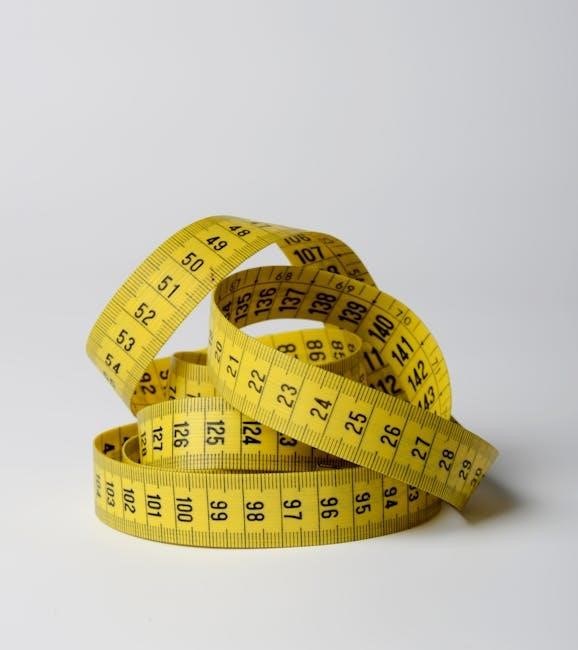The Rating of Perceived Exertion (RPE) Scale is a subjective tool used to quantify the intensity of physical exertion. It is widely applied in sports and medicine.
Originally developed by Gunnar Borg, the scale ranges from 6 to 20, correlating with heart rate, while a modified 0-10 version simplifies effort assessment for practical use.
It helps individuals gauge their exertion levels, ensuring safe and effective exercise progression without overtraining, making it a valuable asset in fitness and rehabilitation settings globally.
1.1 Definition and Purpose
The Rating of Perceived Exertion (RPE) Scale is a subjective measure used to quantify the intensity of physical exertion during activities. Developed by Gunnar Borg, it allows individuals to rate their effort based on feelings of fatigue, breathlessness, and overall physical stress. The scale is designed to help monitor and adjust exercise intensity, ensuring workouts are challenging yet safe. Its primary purpose is to provide a practical, non-technical tool for assessing exertion levels, making it invaluable in sports, fitness, and rehabilitation settings.
1.2 Historical Background
The Rating of Perceived Exertion (RPE) Scale was first introduced by Swedish researcher Gunnar Borg in 1982. Borg developed the original 6-20 scale to correlate perceived exertion with heart rate, providing a practical tool for monitoring exercise intensity. The scale was designed to help individuals communicate their exertion levels effectively, making it a valuable asset in sports and medicine. Over time, the scale evolved, leading to the creation of a modified 0-10 version, which simplified its application for broader use in fitness and rehabilitation settings.

The Borg RPE Scale
The Borg RPE Scale, developed by Gunnar Borg, is a widely recognized tool for measuring perceived exertion. It includes the original 6-20 scale and a modified 0-10 version.
2.1 Original Borg Scale (6-20)
The original Borg RPE Scale ranges from 6 to 20, with 6 indicating “very, very light” effort and 20 representing “maximal” exertion. Developed by Gunnar Borg in 1982, it correlates perceived exertion with heart rate, where an RPE of 15 approximates a heart rate of 150 bpm. The scale uses verbal anchors to help individuals understand exertion levels, making it a practical tool for assessing physical activity intensity in healthy populations. It remains a cornerstone in exercise and sports science for measuring subjective effort during workouts.
2.2 Modified Borg Scale (0-10)
The Modified Borg Scale (0-10) simplifies exertion rating, with 0 representing “nothing at all” and 10 indicating “maximal effort.” This version is easier to understand and apply, making it widely used in clinical and fitness settings. It provides clear verbal anchors, such as “very light” (2-3) and “extremely hard” (9-10), to help individuals accurately rate their exertion. The scale is particularly useful for populations less familiar with intense physical activity, offering a practical and intuitive tool for monitoring exercise intensity and ensuring safe progression during workouts or rehabilitation programs.
2.3 Key Differences Between the Scales
The original Borg Scale (6-20) correlates with heart rate, where an RPE of 15 approximates 150 bpm, while the modified 0-10 scale simplifies effort rating. The 6-20 scale includes more gradations, making it precise for athletes, whereas the 0-10 version is more intuitive for general use. Verbal descriptors differ slightly, with the 0-10 scale offering clearer anchors like “very light” (2-3) and “extremely hard” (9-10). These distinctions make each scale suitable for different populations and exercise intensities, ensuring practical application across varied fitness levels.

How to Use the RPE Scale
Explain the scale, set intensity goals, and have individuals rate their exertion during activity. Monitor effort in real-time to adjust workouts and ensure safe, effective progression.
3.1 Practical Application in Workouts
In workouts, the RPE scale helps tailor intensity to individual fitness levels. Coaches and trainers use it to guide resistance and cardio exercises, ensuring each session is challenging yet safe. Athletes rate their exertion, allowing for real-time adjustments. This method prevents overtraining and enhances performance. For example, setting target RPE ranges helps maintain consistent effort, while post-exercise ratings provide feedback for future planning. This practical approach ensures workouts are both effective and sustainable.
3.2 Rating Exertion Levels
Rating exertion levels involves assigning a numerical value to the effort felt during physical activity. Using the RPE scale, individuals describe their exertion, considering factors like muscle fatigue and breathing difficulty. The Borg scale (6-20) and modified scale (0-10) guide these ratings. For example, an RPE of 7-8 on the Borg scale indicates very light effort, while 15-16 reflects moderate to strenuous exertion. This subjective assessment helps tailor workouts to individual capacity, ensuring safe and effective exercise progression. Accurate ratings enhance training outcomes and reduce injury risks.
Benefits and Importance of RPE
The RPE scale effectively monitors exercise intensity, enhances safety by preventing overexertion, and provides individualized feedback, making it a versatile tool in fitness and rehabilitation settings.
4.1 Monitoring Exercise Intensity
The RPE scale is a reliable method for monitoring exercise intensity, allowing individuals to adjust their workouts based on physical sensations like fatigue and breathlessness. By rating exertion levels, participants can ensure they are within a safe and effective training zone, optimizing performance without risking overexertion. This subjective yet effective tool helps maintain consistency and balance in exercise routines, making it invaluable for both athletes and general fitness enthusiasts alike.
4.2 Enhancing Workout Safety
The RPE scale enhances workout safety by providing immediate feedback on physical exertion. It allows individuals to identify and address potential overexertion early, reducing injury risks. This subjective measure ensures personalized limits are respected, making it especially useful for those with health conditions or recovering from injuries. By promoting self-awareness, the RPE scale helps create a safer, more tailored approach to exercise, ensuring sustainable progress without compromising well-being.

RPE and Heart Rate
The RPE scale correlates with heart rate, aiding in monitoring exercise intensity without needing continuous heart rate tracking, offering a practical alternative for workout assessment.
5.1 Correlation Between RPE and Heart Rate
The Borg RPE Scale shows a strong correlation with heart rate, where an RPE of 15 corresponds to approximately 150 beats per minute. This relationship allows individuals to estimate exercise intensity without continuous heart rate monitoring. The original Borg scale (6-20) was specifically designed to align with heart rate values, providing a practical tool for gauging physical exertion. While individual variations exist, the RPE-heart rate correlation remains a reliable method for monitoring and adjusting workout intensity effectively.
5.2 Using RPE Without Heart Rate Monitoring
The RPE Scale is a practical tool for assessing exertion without heart rate monitoring. It relies on an individual’s subjective perception of effort, making it accessible in any setting. The modified 0-10 scale simplifies understanding, allowing users to gauge exertion based on physical sensations like muscle fatigue and breathing difficulty. This method ensures individuals can monitor and adjust their exercise intensity effectively, even without technological devices, promoting safe and tailored workouts. Its simplicity enhances its universal applicability in fitness and rehabilitation.

Applications in Sports and Medicine
The RPE Scale is widely used in sports to optimize training and in medicine to monitor patient exertion during tests, ensuring safe and effective physical activity management.
6.1 Use in Athletic Training
The RPE Scale is a practical tool in athletic training, enabling coaches and athletes to optimize workout intensity and prevent overtraining. By rating exertion levels, athletes can tailor their efforts to specific goals, ensuring balanced progression. This subjective measure allows for real-time adjustments, making it highly adaptable to individual needs. The scale is particularly useful in team sports, where consistent effort monitoring is crucial. It enhances performance tracking and safety, providing a reliable method to gauge physical stress without advanced equipment, thus fostering effective and personalized training programs.
6.2 Medical Applications
The RPE Scale is widely used in medical settings to assess patient exertion during physical tests, such as the 6-minute walk test. It helps clinicians monitor exercise tolerance and fatigue levels, aiding in the diagnosis and management of respiratory and cardiovascular conditions. The scale is particularly useful for tailoring rehabilitation programs, ensuring safe and effective progression for patients. By providing a subjective yet reliable measure of exertion, it supports personalized care and improves outcomes in chronic disease management and post-rehabilitation recovery.
Limitations of the RPE Scale
The RPE Scale’s reliance on self-reported perceptions leads to variability among users. Individual differences in pain and effort interpretation can cause inconsistent and subjective ratings, affecting reliability in some contexts.
7.1 Subjectivity and Variability
The RPE Scale is inherently subjective, as ratings vary based on individual perceptions of effort, pain, and fatigue. Personal factors like fitness level, mood, and past experiences influence scores, leading to inconsistent measurements. For example, one person’s RPE of 7 might feel different from another’s, even under similar conditions. This variability can make it challenging to standardize and compare results across individuals or sessions.
7.2 Dependence on Individual Perception
The RPE Scale heavily relies on personal interpretation, making it prone to individual differences. Factors like physical conditioning, mental state, and pain tolerance significantly influence ratings. For example, two people with identical heart rates may report different RPE scores due to varied perceptions of exertion. This subjective nature means the scale’s accuracy depends on the user’s ability to self-assess, limiting its reliability in standardized assessments and highlighting the need for personalized application in training or rehabilitation programs.
The Perceived Exertion Scale is a valuable, subjective tool for assessing exercise intensity. Its simplicity and adaptability make it widely used in sports and medicine, though limitations exist.
8.1 Summary of Key Points
The Perceived Exertion Scale is a subjective measure for assessing exercise intensity, developed by Gunnar Borg. It ranges from 6-20, correlating with heart rate, while a modified 0-10 version simplifies effort assessment. The scale helps individuals gauge exertion, ensuring safe and effective exercise progression. It is widely used in sports, medicine, and fitness due to its practicality, though its subjectivity and dependence on individual perception are noted limitations.
8.2 Future Implications
The Perceived Exertion Scale is expected to evolve with advancements in technology, potentially integrating real-time exertion monitoring. Future applications may expand into personalized fitness plans and rehabilitation programs, enhancing exercise safety and efficiency. Researchers aim to refine the scale’s objectivity while maintaining its simplicity. As awareness grows, its adoption in diverse fields like sports and medicine is likely to increase, solidifying its role as a practical tool for optimizing physical performance and health outcomes globally.



